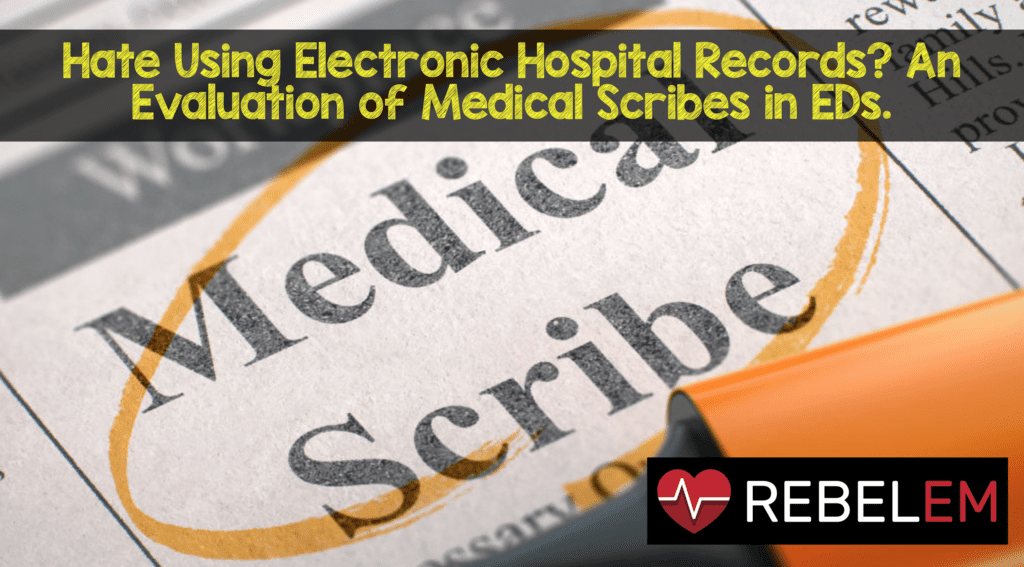
 Background: Emergency Physicians and trainees spend the majority of their clinical day performing clerical tasks which are widely disliked(Füchtbauer LM, 2013). Core tasks such as obtaining information, cognitive synthesis and communication are punctuated with other tasks including hours of electronic hospital record data entry, relaying information to multiple colleagues, sending investigation requests, booking beds, coordinating patient movements and chasing investigations(Kee R, 2012). In addition to reducing physician productivity and contributing to work place dissatisfaction, the clerical tasks performed by doctors are a waste of medical resources. Patients need physicians to be available to them, rather than spending 30-43% (Robert G. Hill Jr., 2013)of their shift on clerical data entry requiring multiple “mouse clicks” for even simple tasks. Many of these non-core tasks may be amenable to task substitution leaving Emergency Physicians free to focus on “doctoring”.
Background: Emergency Physicians and trainees spend the majority of their clinical day performing clerical tasks which are widely disliked(Füchtbauer LM, 2013). Core tasks such as obtaining information, cognitive synthesis and communication are punctuated with other tasks including hours of electronic hospital record data entry, relaying information to multiple colleagues, sending investigation requests, booking beds, coordinating patient movements and chasing investigations(Kee R, 2012). In addition to reducing physician productivity and contributing to work place dissatisfaction, the clerical tasks performed by doctors are a waste of medical resources. Patients need physicians to be available to them, rather than spending 30-43% (Robert G. Hill Jr., 2013)of their shift on clerical data entry requiring multiple “mouse clicks” for even simple tasks. Many of these non-core tasks may be amenable to task substitution leaving Emergency Physicians free to focus on “doctoring”.
Emergency Medicine scribes (“scribes”) may or may not be a partial solution (Bastani A, 2014)to Emergency Department (ED) workforce capacity building. Scribes function as a bedside clerical assistant to the physician. They are becoming more common in the US, but not elsewhere. Scribes cost money, which represents a health opportunity cost. There have been a number of emergency studies that have evaluated before and after scribe implementations (Hess JJ, 2015)(Arya R, 2010)and one single-centre study that randomised scribes to pediatric and adult areas of their ED (Heaton HA, 2016). There have not been any independently-funded, level II evidence studies about the effect of the scribe on emergency department metrics, nor any published information regarding patient safety.
An Australian collaboration (philanthropically funded) recently undertook a prospective, multicentre randomised trial of scribes in the Emergency Department and their results were published in the BMJ in January 2019.
Article Being Reviewed: Walker K et al. Impact of Scribes on Emergency Medicine Doctors’ Productivity and Patient Throughput: Multicentre Randomised Trial. BMJ 2019. PMID:30700408
Clinical Question: Does the use of medical scribes increase physician productivity in the Emergency Department (ED)?
What They Did: A prospective, multicentre, non-blinded, randomised control trial was undertaken by Prof Katie Walker and her co-authors. Five EDs in Victoria, Australia, participated in this study. These 5 sites included county (metropolitan, tertiary, pediatric, regional referral) and private tertiary (not for profit) Emergency Departments. Trained scribes were randomly allocated to emergency physicians and normal workflow was observed. Scribes accompanied one physician for their entire shift and these were compared to non-scribed shifts.
All patients attending the Emergency Department were eligible for scribe involvement. Eighty-eight physicians and 12 scribes participated in the study and patients within the scribed and non-scribed shifts showed the same baseline demographics. Any patient safety incidents were reported to the Emergency Medicine Events Register – a privileged, cloud-based, specialty specific incident reporting system.
- The primary outcome measurement was physician productivity (total patients per hour per doctor)
- The Secondary outcomes measurements were door-to-doctor times, emergency department length of stay and rates of primary consultations. Primary consultations were defined as “when the physician was the main physician for the patient” and excluded medical triage and handover patients where another physician was the main provider. In addition, a cost benefit analysis of scribes was performed.
Outcomes:
Primary:
- The primary outcome was that scribes increased Emergency physician productivity from 1.13 (95% CI 1.11 – 1.17) to 1.31 (95% CI 1.25-1.38) patients per hour per doctor (a 15.9% gain) with a p <0.001.
Secondary:
- Primary consultations increased from 0.83 to 1.04 patients per hour per doctor (25.6% gain) p<0.001.
- There was no change in door-to-doctor times.
- The median length of stay in the Emergency Department reduced by 19 minutes from 192 to 173 (p<0.001).
- There were 16 patient safety incidents reported to the EMER database. This represents a reporting rate of 1/300 patients. The most common error was selecting the incorrect patient from the electronic hospital record. All cases were near misses with the error being identified prior to any action taken. In 50% of the reported incidents the scribe identified potential incidents for other physicians’ patients in the department and intervened hence preventing the incident.
- In Australia, the role is cost-effective, even when the cost of training a scribe is included.
Strengths:
- This was the first prospective, multicentre, randomised, independently funded, study involving medical scribes in any setting.
- Study took place in real time with no alternation to normal workflow allowing Emergency Physician decision autonomy regarding what task or patient to attend to at any point.
- This was the first study to report patient safety incidents.
- Use of regression logistic to minimize bias.
Limitations:
- This study was limited to a single state within Australia.
- Night shifts and public holiday shifts were excluded from this study
Possible Overvaluing of Scribe Impact:
- Potential Hawthorne effect given it was not possible to blind this study.
- Junior doctors were excluded from this study given the similarity between wages since this was presumed to negate any economic advantage of the scribe.
- Voluntary self-reporting incident review methodology (usually overestimates minor events and underestimates major events).
- There was no patient safety incident reporting from the control group, incidents only relate to the scribed group.
- If a scribe turned up for a shift and their allocated physician was sick, they were reallocated to an alternate physician and the scribed shift was included in the scribed data. If the scribe was unable to work, the physician worked unassisted and the allocated shift was counted as a non-scribed shift.
Possible Undervaluing of Scribe Impact:
- Impact on RVU (Relative value unit) and change in billing values were not measured.
- This study did not capture unreported physician overtime (time beyond rostered shift undertaking patient charting).
- Physicians were largely inexperienced using scribes and this may have underestimated productivity.
- Physicians were offered 90 minutes of training online and a 90-minute dial-in-telephone training session before receiving scribes. Very few physicians took up the offer of training. Scribes were then left to train their doctors during clinical shifts.
- Reassigning junior doctors from assistant roles in observation units to seeing new patients in acute areas (due to the scribe undertaking all assistant tasks instead) was not counted in the productivity data.
Discussion:
- There is increasing governance regarding documentation and recordkeeping, requiring more details recording of information.
- Most Emergency Medicine services globally struggle to reconcile demands with limited resourcing.
- Health IT systems are largely not purpose built for reducing physician data entry loads, rather they require more data to be collected than has ever been required previously.
- The use of highly trained, senior medical decision makers to undertake clerical data entry is not fiscally responsible if a reasonable and cheaper alternative exists.
- This was the first ever multicentre, randomised control trial involving medical scribes
- The study demonstrated a positive impact on productivity and reduced patient length of stay
- Scribes may offer a partial solution and improve resource management
- This study demonstrated that when scribes allocate patients to providers occasional errors may happen
- Scribes were cost effective – however this would need to be re-examined if junior doctors or other non-physician providers were allocated scribes
- Further studies should be undertaken in Emergency Department settings outside Australia and in other settings such as primary care and ambulatory clinics.
- Longer-term studies would be required to study effect on burn out/career longevity.
- Patients and physicians both want to see more of each other, this study demonstrates a cost-effective way of making this happen.
Author Conclusion:
“Scribes provide a safe, cost effective partial solution to improve resource management and service delivery within ED.”
Clinical Take Home Points:
- Medical scribes improve emergency physician productivity and improve patient throughput
- They are safe
- They are cost-effective
- May provide a partial solution to ED capacity building
Guest Post By:

Twitter: @Melanie47814838
References:
- Hill RG Jr et al 4000 clicks: a productivity analysis of electronic medical records in a community hospital ED. Am J Emerg Med 2013 PMID: 24060331
- Füchtbauer LM et al Emergency department physicians spend only 25% of their working time on direct patient care. Dan Med J 2013 PMID: 23340186
- Kee R et al. One hundred tasks an hour: an observational study of emergency department consultant activities Emerg Med Australas. 2012 PMID: 22672170
- Shultz CG et al The use of medical scribes in health care settings: a systematic review and future directions. J Am Board Fam Med 2015 PMID: 25957370
- Heaton HA et al Effect of scribes on patient throughput, revenue, and patient and provider satisfaction: a systematic review and meta-analysis. Am J Emerg Med 2016 PMID: 27534432
- Bastani A et al An ED scribe program is able to improve throughput time and patient satisfaction. Am J Emerg Med 2014 PMID: 24637134
- Hess JJ, e. (2019) Scribe impacts on Provider Experience, Operations, and Teaching in an Academic Emergency Medicine Practice. W J Emerg Med 2015 PMID:26587079
- Arya R, e. (2019). Impact of scribes on performance indicators in the emergency department. Acad Emerg Med 2010 PMID: 20536801
- Heaton HA, e. (2019). Impact of scribes on patient throughput in adult and pediatric academic EDs. Am J Emerg Med 2016 PMID: 27450391
For More on this Topic Checkout:
- Chris Gray at St. Emlyn’s: >JC – Do We Need Scribes in the ED?
Post Peer Reviewed By:Anand Swaminathan, MD (Twitter: @EMSwami) and Salim R. Rezaie, MD (Twitter: @srrezaie)
The post Hate Using Electronic Hospital Records? An Evaluation of Medical Scribes in Emergency Departments. appeared first on REBEL EM - Emergency Medicine Blog.
